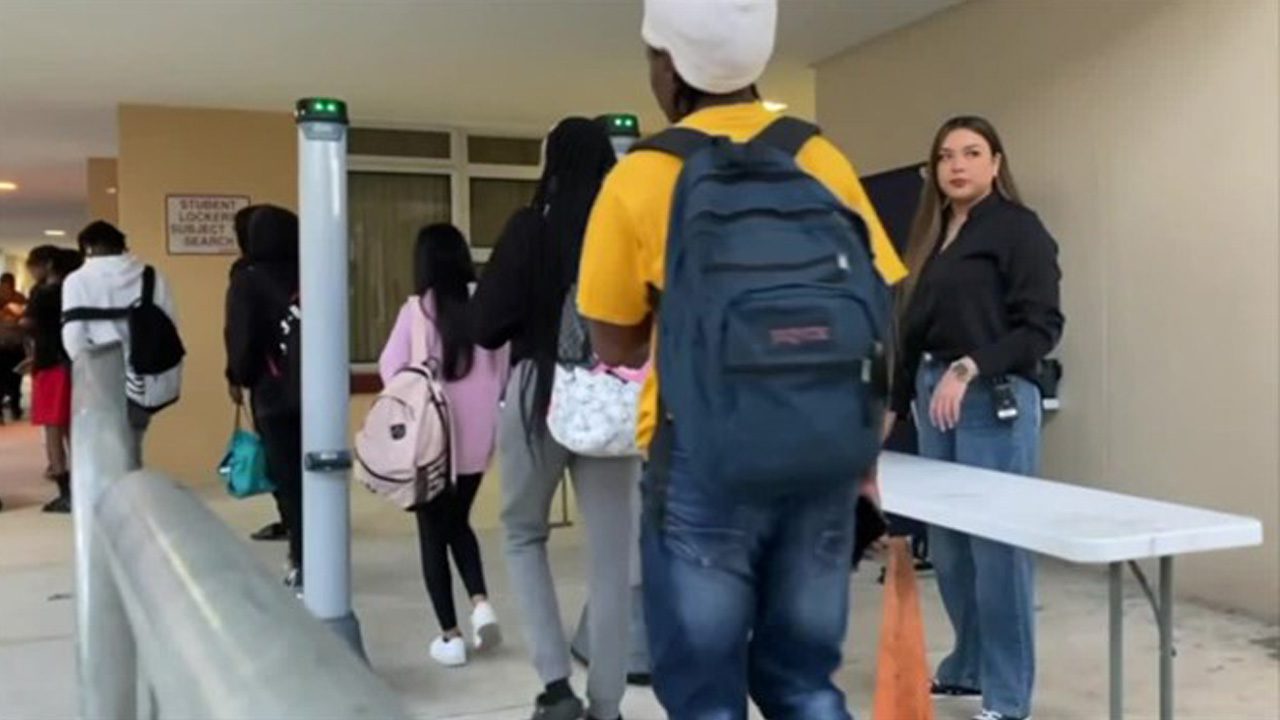Orange schools tried, then cut, weapons detectors others are testing, citing cost
Orlando Sentinel | By Alyssa Gary | August 22, 2024
Orange County Public Schools proposed installing walk-through weapons detection systems in all high schools this school year but nixed the plans when they proved too expensive given the staff needed to run them efficiently.
The system OCPS tried out at several campuses last school year — but decided not to install at all 23 high schools — is similar to the one Broward County schools debuted last week to long lines of frustrated students.
In those South Florida high schools, hundreds of students waited to go through the screening devices before entering campuses, delaying the start of school for many teenagers, the South Florida Sun-Sentinel reported. By this week, most Broward students could quickly walk through the metal detectors, though administrators said the devices required a lot of security staff to make the start of the school day go smoothly, the paper reported.
Those concerns in Broward echoed what OCPS discovered — that making sure students could quickly walk through the devices and get to class on time took far more school staff than anticipated.
The Osceola County school district tried out the same weapons detectors at one school, Osceola High School, as school started Aug. 12. Though there were were delays initially, administrators consider the rollout successful.
School safety has been a priority of public schools for years, but the fatal shootings at Marjory Stoneman Douglas High in Parkland in 2018 prompted an enhanced focus on keeping weapons off school grounds.
OCPS leaders said they piloted the new system called Opengate — whose devices are similar to those used at Orlando Magic games and other large events — as it was touted as a fast and easy way to screen for “mass casualty shooting weapons.”
Administrators hoped the devices two poles with alarms at the top could screen large numbers of students entering campuses each morning without requiring them to take off backpacks or hand over purses. But before they walked through, students had to remove laptops and large binders from their backpacks and hand them to employees, so the process was not without stops and starts.
And when the district tried out the system last school year, administrators and deans worked the system, and that meant they were not doing their other morning duties, said Melissa Byrd, an Orange County School Board member.
“You’re trying to keep everybody safe,” Byrd said, “and yet, you’re taking away all the administrators that we need to have available to do monitoring of our students once they come in.”
If the school district wanted to continue using the weapons detectors this year, each of 23 high schools would have to hire about 10 new people, said Byrd, whose district includes Wekiva High school, the first OCPS school to test the system.
“There’s just no way we can afford to do that,” Byrd said.
The system also did not catch any major weapons when it did screen OCPS students arriving for school, she added.
Dewey Cornell, a psychologist and professor who researches school safety at the University of Virginia, said violence prevention in schools should focus on supporting troubled students before they bring weapons on campus.
“In my view, weapon detection systems are expensive and have questionable effectiveness,” Cornell wrote in an email. “Schools should place emphasis on more meaningful prevention efforts and use methods that have scientific support.”
OCPS said it is continuing other safety strategies, including random searches and a new locked-door policy. It also will use the Opengate devices for large events and random weapon screenings, it added.
The school district spent $475,000 on the Opengate devices last year and announced a pilot to test it at seven high schools during the 2023-24 school year, planning that it would be on all campuses in August.
But soon after the systems debuted at Wekiva and then Boone High School, problems cropped up, including lines that kept students from getting to first-period class on time. The district cut the pilot short, trying out the devices at only four high schools.
The biggest problem, Superintendent Maria Vazquez said at a late January school board meeting, was that screening all students every morning took more employees than expected.
“We have found the need for additional staff,” she said.
Board member Alicia Farrant, whose district includes Boone, said she heard from plenty of parents and staff upset about the rollout. “I don’t feel the system is ready,” she said at that meeting.
In Osceola, Osceola High was the county’s first to try using the technology.
“Great start to the first day, Kowboys!” the school posted on its Facebook on the first day of school last week. “Open Gate screening went well.”
The weapons screenings finished by 7:45 a.m. that day, and students got to class shortly after, according to the school’s social media. But the school’s website says students are considered late to class if they enter after 7:15 a.m.
Those first-day delays were expected, said Dana Shafer, a school district spokesperson, and the district modified its class bell schedule to account for that.
By the end of the first week of school, the high school was screening students quickly and first-period classes were starting on time, said Principal Elizabeth Kennedy in an email.
“Everything is running very smoothly … much smoother and better than even I expected,” she said in the Thursday email. “We continue to learn which items set off the devices, such as perfume bottles, but that is also a reminder to our students that Opengate is working well.”
In South Florida, delays in Broward County’s weapons screening last week caused hundreds of students to line up outside, waiting to enter class for more than 45 minutes, the Sun Sentinel reported.
Superintendent Howard Hepburn apologized on Aug. 12 — the first day of school for many Florida public schools — for the long lines, and he urged students to take metal items out of their bags before approaching the detectors.
Students’ binders and water bottles were among the items setting off the devices’ alarms, Broward officials said. And Hepburn said it did take a lot of staff to monitor them.
“We’re using a lot of staff right now to make it work, but as we become more efficient, we should be able to peel back some of that stuff to use in other places on campus,” he said at a Broward County School Board meeting this week, the Sun Sentinel reported.
Several other districts in Florida, including those in Miami-Dade and Indian River counties, are considering or testing the machines to boost school security.






